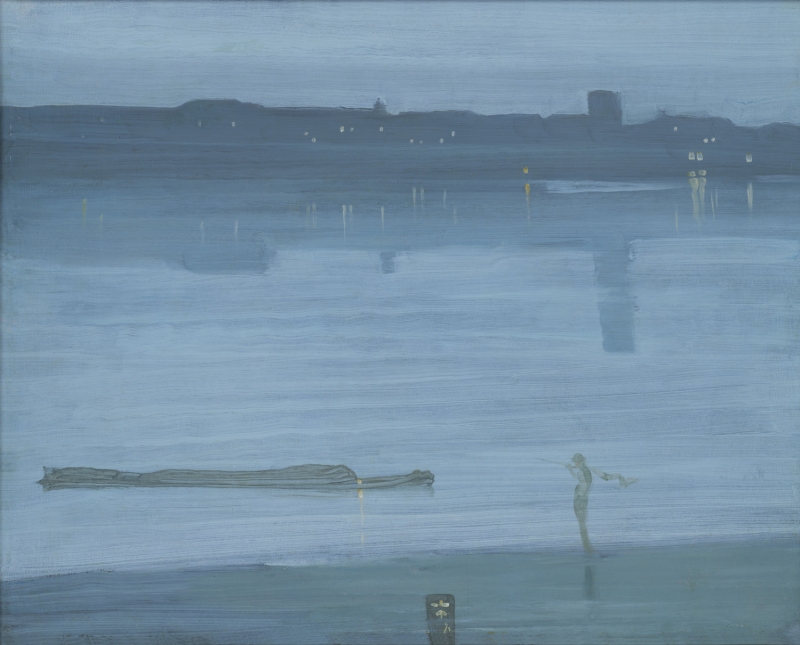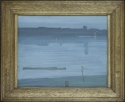Home > Catalogue > People > William Cleverly Alexander (related works) > Catalogue entry
Provenance
- 1871: William Cleverly Alexander (1840-1916) , London;
- 1916: on his death, passed to the his daughters, the Misses Rachel Alexander (1875-1964) and Jean Ingelow Alexander (1877-1972) ;
- 1972: bequeathed by Miss Rachel and Miss Jean Alexander to the National Gallery and transferred in the same year to the Tate Gallery.
It was exhibited at the Dudley Gallery, London, in 1871 (cat. no. 265), priced at £210, and bought from the exhibition by W. C. Alexander. Whistler's mother mentioned the purchase :
'Did I not write you of a Moonlight picture of this river exhibited in the Dudley Gallery last Autumn? We have formed a friendship with Mr Alexander & his family since he bought that in June. he is a Banker ... [of] the firm of "Alexander & Cunliffe".' 1
Exhibitions
- 1871: 5th Winter Exhibition of Cabinet Pictures in Oil, under the Management of the Committee of the Dudley Gallery, London, 1871 (cat. no. 265) as 'Harmony in Blue-Green – Moonlight'.
- 1879: III Summer Exhibition, Grosvenor Gallery, London, 1879 (cat. no. 192) as 'Nocturne in Blue-Green'.
- 1883: Possibly Exposition Internationale de Peinture, Galerie George Petit, Paris, 1883 (cat. no. 5) as 'Nocturne en bleu et argent'.
- 1884: Probably Exposition internationale de peinture et de sculpture, Société des XX, Brussels, 1884 (cat. no. 2) as 'Nocturne en bleu et argent, No. 1'.
- 1892: Nocturnes, Marines & Chevalet Pieces, Goupil Gallery, London, 1892 (cat. no. 18) as 'Nocturne, Blue and Silver – Chelsea'.
- 1905: Memorial Exhibition of the Works of the late James McNeill Whistler, First President of The International Society of Sculptors, Painters and Gravers, New Gallery, Regent Street, London, 1905 (cat. no. 31) as 'Nocturne, Blue and Green'.
- 1905: Œuvres de James McNeill Whistler, Palais de l'Ecole des Beaux-Arts, Paris, 1905 (cat. no. 72) 'Nocturne en bleu et vert. – (Nocturne in Blue and Green.)'.
It was exhibited as a 'Harmony' and, at the same time, a 'Moonlight' in 1871, and it was rechristened and shown as a 'Nocturne' from 1879 on.
1871: On 11 October 1871 the artist Edward John Poynter (1836-1919) wrote to Whistler apologising that he had not arrived at the Dudley Gallery in time to help hang this painting and Variations in Violet and Green [YMSM 104]:
'One of yours is properly placed, but the other "the moon-light"seems to have riled the hangers for they have placed it badly. ...
If you think my opinion worth anything, perhaps you will allow me to say how very much I admire both the paintings, but especially the moonlight, which renders the poetical side of the scene better than any moonlight picture I ever saw. I wish I had been there to see justice done to it.' 2
Whistler asked Walter Greaves (1846-1930) about the exhibition:
'You tell me in your letter that you had seen someone who was pleased with the appearance of the two pictures in the Dudley - but by this time I suppose you have both been there and so you must write me a line and tell us all about it! how they stand their ground and the impression they seem to produce and the rest of it - I suppose there is as yet nothing in the papers about the gallery - I have seen nothing myself.' 3
Walter and his brother Henry Greaves (1843-1904) went to the Dudley and reported favourably. Whistler replied: 'I am very glad you and Harry have been to the Dudley - and that the two "harmonies" look swell among the crowd.' 4
This was the first exhibition in which Whistler exhibited a 'Nocturne', although none were described with that title until the following year (Nocturne: Blue and Gold - Southampton Water [YMSM 117] and Nocturne in Blue and Silver [YMSM 118]). The Athenaeum, cited by Whistler's mother (see above), praised 'its exquisite harmony in chromatics.' 5 The Dudley exhibition included both Nocturne: Blue and Silver - Chelsea [YMSM 103] and Variations in Violet and Green [YMSM 104], and a review that appeared in The Times in 1871 was perhaps the most sensitive and truly appreciative account of Whistler's ideas to be published:
'They are illustrative of the theory, not confined to this painter, but most conspicuously and ably worked out by him, that painting is so closely akin to music that the colours of the one may and should be used, like the ordered sounds of the other, as means and influences of vague emotion; that painting should not aim at expressing dramatic emotions, depicting incidents of history, or recording facts of nature, but should be content with moulding our moods and stirring our imaginations, by subtle combinations of colour through which all that painting has to say to us can be said, and beyond which painting has no valuable or true speech whatever. These pictures are illustrations of this theory. They contain the least possible amount of objects, nothing, in fact, beyond the faintest indications of river surface under moonlight, a dim mass of faintly lighted building closing the high horizon, and reflected in the water, and, for foreground objects ... a scarcely intelligible barge and faint figure of a mudlark ... The only way to explain the perspective of the pictures is to suppose them painted from a high window. The colour, consistently with the theory of the painter, is carried out into the frames by means of delicate diaperings and ripplings of faint greens and moony blues on their gold, and the Japanese influence in which the painter delights is carried even to the introduction of the coloured cartouche, which on the Japanese screen bears the address of the painter or seller. Mr. Whistler has introduced his own monogram or symbol in this way, carefully attuning the colour of the cartouche to the dominant harmony of his picture. With all the apparent slightness of the work, the management of colour all through is governed by the subtlest calculation, and the gradation and juxtaposition of delicate tones appeal to the finest chromatic susceptibles ... Mr. Whistler's portfolio of Etchings ... which takes rank with the best modern work of the kind ... shows that his avoidance of precise delineation in these pictures is calculated, and not the result of any want of drawing power.' 6
Parts of this review match Whistler's ideas so closely that they might almost have been dictated by him. 7 Reviews varied greatly: The Examiner on 28 October praised Nocturne: Blue and Silver - Chelsea and Variations in Violet and Green [YMSM 104] as 'two experiments in the combination of colour … wonderful things', but on 10 November 1871 the Morning Advertiser dismissed them as 'eccentric productions' and mere 'smudges'.
1879: By contrast, when it was shown at the Grosvenor Gallery in 1879, under its new title, 'Nocturne in Blue-Green', The Mask published a cartoon with this nocturne drawn almost entirely in horizontal lines, with no recognisable features at all. 8 However, other journalists approved of it, in qualified terms, describing it, for instance, as 'a really beautiful river piece full of sentiment and poetry, that shows what Whistler used to paint before fortune smiled upon and spoiled him.' 9 In the aftermath of the Whistler v. Ruskin trial and his bankruptcy, it is assumed that this comment was ironic.
1881: Théodore Duret (1838-1927) described a 'Nocturne en bleu et or, no. 1' as typical of Whistler's Nocturnes, and the description fits this painting:
'L'impression que l'artiste veut fixer sur la toile est celle du clair de lune par une belle nuit. Il a choisi comme sujet une rivière avec ses bords, parce qu'aprés tout il lui faut bien un motif pour porter la couleur .. [Et] ce qui est appelé à communiquer aux yeux l'effet que le peintre veut rendre, ce ne sont ni des lignes ni des contours, mais la gamme générale de tons bleus argentés qui, avec des inflexions de clair et d'ombre, couvre toute la toile ... il n'y a que deux choses sans contours et sans formes arrêtées, mais fort saisissables cependant, et arrivant même à produire une impression puissante de l'air et une gamme de tons délicate et vibrante.' 10
1883-1884: It may have been shown at the Galerie Georges Petit in 1883 (cat. no. 5) as 'Nocturne en bleu et argent' (but see Nocturne in Blue and Silver [YMSM 151]).
It may also have been the 'little Nocturne blue & silver' that Whistler asked Charles William Deschamps (1848-1908) to retrieve from his studio, insure, and send to the exhibition of the Société des XX in Brussels in 1884, and not only that, but arrange for it to be framed on its arrival. If so, it was rechristened as 'Nocturne en bleu et argent, No. 1' (cat. no. 2) (which is what Duret had called the painting that he had described in 1881). 11 In Brussels, it was described poetically in La Libre Revue: 'La Nocturne paraît vu à travers une gaze tissée avec des rayons de lune. Il évoque dans son air bleu une vision féerique ... la Shakespeare, mais plus tendre, plus diaphane, plus fluide encore.' 12
1892: For the catalogue of Whistler's important retrospective at the Goupil Gallery, he selected two earlier reviews to accompany this painting:
' "Mr. Whistler confines himself to two small canvases of the nocturne kind. One is covered with smudgy blue and the other with dirty black." Saturday Review.
A reputation, for a time, imperilled by original absurdity." ̶ F. Wedmore, "Academy."
'I think Mr. Wedmore takes the Nocturnes and Arrangements too seriously. They are merely first beginnings of pictures, differing from ordinary first beginnings in having no composition. The great originality was in venturing to exhibit them." P. G. Hamerton, " Academy." ' 13
By contrasting these mocking and brutal criticisms, by Frederick Wedmore (1844-1921) and Philip Gilbert Hamerton (1834-1894), with Nocturne: Blue and Silver - Chelsea, Whistler emphasized its light, bright colouring and carefully controlled composition. Whistler also chose a photograph of the painting for reproduction in the Album of photographs produced for sale.
A reviewer at that time agreed entirely with Whistler, citing this painting as 'of particular charm', a 'really exquisite vision of the pale night.' 14
Notes:
1: A. M. Whistler to J. H. Gamble, 5 November 1872, GUW #06552.
3: [October/November 1871], GUW #11469.
4: Whistler to W. Greaves, [14 November/December 1871], #11496.
5: 'Fine Arts, Winter Exhibition of Cabinet Pictures in Oil,' The Athenaeum, 28 October 1871, p. 565.
6: Anon., [Tom Taylor], 'Dudley Gallery. – Cabinet Pictures in Oil', The Times, London, 14 November 1871, p. 4.
7: See his letter to G. A. Lucas, [18 January 1873], GUW #09182.
8: Anon., 'A Gaiety in Gilt, and three Noctoffs in a Twinkle. Connie soit qui mal y pense', The Mask, London, vol. 2, 17 May 1879, repr. p. 4. Press cutting in GUL Whistler LB 11/21.
9: Anon., 'The Grosvenor Gallery', Freeman's Journal, London, 8 May 1879, p. 6.
10: Duret 1881, Whistler [more] .
11: Whistler to Deschamps, 8 and [11] January 1884, GUW #07908 and #07909.
12: La Libre Revue, 29 February 1884, p. 254.
13: (cat. no. 18) reprinted in Whistler 1892 [more] , pp. 308-09.
14: Anon., 'Mr. Whistler's Paintings', London Evening Standard, London, 21 March 1892, p. 3.
Last updated: 8th June 2021 by Margaret







